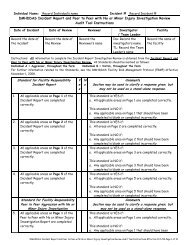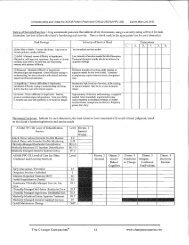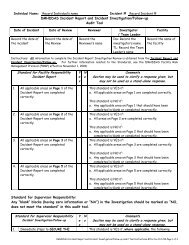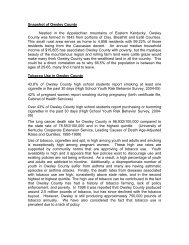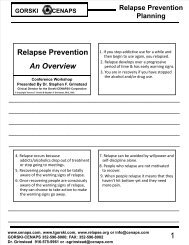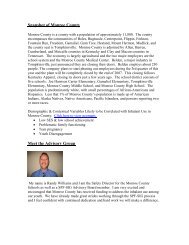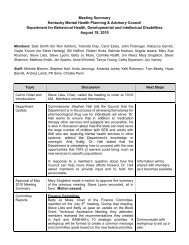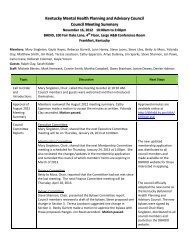kentucky commission - Kentucky Cabinet for Health and Family ...
kentucky commission - Kentucky Cabinet for Health and Family ...
kentucky commission - Kentucky Cabinet for Health and Family ...
Create successful ePaper yourself
Turn your PDF publications into a flip-book with our unique Google optimized e-Paper software.
KENTUCKY COMMISSIONONSERVICES AND SUPPORTSFOR INDIVIDUALS WITH MENTAL RETARDATIONAND OTHER DEVELOPMENTAL DISABILITIESDecember 5, 2007Fair Oaks, 4 th FloorFrank<strong>for</strong>t, <strong>Kentucky</strong>MEMBERS PRESENTUndersecretary William Hacker (<strong>for</strong> Secretary Emberton)Deputy Commissioner Banahan (<strong>for</strong> Commissioner Crouch)Harold KleinertPat SeyboldClyde LangCommissioner John BurtGwynn RoysterRepresentative Jimmie LeeKaren GardnerWilliam ShawLouise UnderwoodCathy EdwardsGayle ReesDave Mathes (<strong>for</strong> Ex. Dir. Sherri Greer)MEMBERS ABSENTF. Roy ShirleyHerman Terry LeighSenator Tom Bu<strong>for</strong>dMalkanthie McCormick, M.DMarsha VanhookSenator Julie DentonGlenna TaylorOPENING REMARKSThe meeting was called to order by Undersecretary Hacker.REVIEW OF MINUTESA motion was made by Representative Lee to accept the minutes as submitted<strong>and</strong> seconded by Gayle Rees. The motion passed.MEDICAID WAIVER UPDATE• Michelle P. WaiverCarrie Banahan, Deputy Commissioner from Medicaid, gave an update on theMichelle P. Waiver. There has been a delay in the implementation date dueto problems with the computer system used <strong>for</strong> billing. The projectedimplementation date is now April 1, 2008. The system change request hasbeen submitted. Regulations are being drafted. Plans are to serve thoselisted as “critical” first, then those that have been on the waiting list thelongest. There will be training in February <strong>for</strong> providers. In clarifying the
subject of Independent Case Managers, the provider can either offer casemanagement services, or other waiver services, but not both on an individualbasis. Exceptions may be made in rural areas due to lack of providers.• ABI Long Term Care WaiverThe waiver document was submitted to the Centers <strong>for</strong> Medicare <strong>and</strong>Medicaid Services (CMS) in July 2007. After revisions, they hope to haveapproval soon.• Self Directed Option (SDO)A state plan amendment was <strong>for</strong>mally submitted two weeks ago. Medicaid iswaiting on approval. This will be a pilot program serving 200 people in allthree waivers (Home <strong>and</strong> Community Based Services, Supports <strong>for</strong>Community Living, <strong>and</strong> Acquired Brain Injury). If the pilot is successful,Medicaid can submit a state plan amendment to exp<strong>and</strong> this option.• Money Follows the PersonThis grant was awarded in May 2007 to support transition from institutionsback into the community. The implementation protocol was submitted toCMS Nov. 1 st . There is currently no time frame as to the implementationdate. This program plans to serve 50 – 70 people transitioning from NursingFacilities <strong>and</strong> ICF’s/MR during the first year, <strong>and</strong> exp<strong>and</strong> to include ABI thesecond year.DEPARTMENT FOR MENTAL RETARDATION UPDATEBetsy Dunnigan gave this report.• Crisis Stabilization UpdateThere was a report h<strong>and</strong>ed out in each packet summarizing the number ofcalls in the different regions during the months of March throughSeptember. Most calls appear to be about aging caregivers <strong>and</strong>behavioral issues.• Waiting List UpdateThe Supports <strong>for</strong> Community Living (SCL) waiting list report wasdistributed to the Commission members. There are currently 2644 peopleon the SCL Waiting list. Of that, 245 are listed as urgent. These will bethe first to be offered services through the Michelle P. Waiver.Approximately 2/3 of the people on the waiting list receive some servicesthrough another waiver, Medicaid program (such as EPSDT), or stategeneral fund program.Many people on the list are focused on future residential needs asopposed to current needs. Allocations continue to be made <strong>for</strong> individualsmeeting the emergency criteria <strong>for</strong> SCL services. There are 100 new slotsavailable <strong>for</strong> allocations <strong>for</strong> emergencies in this fiscal year.
CONSUMER DIRECTED OPTION (CDO) UPDATEDeborah Anderson gave this update.• CDOThere are currently 816 people receiving services through CDO (505HCB; 32 SCL; <strong>and</strong> 2ABI). Not all have hired providers <strong>for</strong> services.Support brokers’ case loads are currently at the maximum in certainRegions. The lack of HCB providers is causing more people to chooseCDO, especially in the KIPDA area. DMS <strong>and</strong> DAIL have gone back tobasics on the individual budgets. Level 1 is based on historical budget toinclude services prior authorized that have been received as well as thosethat were not received due to lack of available providers. Level II budgetaddresses catastrophic events that occur in the individual’s life.Additional training is needed <strong>for</strong> assessors to determine the actual amountneeded rather than just asking <strong>for</strong> the maximum amount to better servethe CDO budget. There have been a couple exceptions established <strong>for</strong>certain circumstances. Goods <strong>and</strong> Services may possibly be available bymid-January 2008.• Resource MarketSince implementation in October 2007, there have been 853 calls. Themajority of the calls relate to persons with physical disabilities, one call <strong>for</strong>mental health services <strong>and</strong> no calls to date <strong>for</strong> persons with intellectualdisabilities. The Commission was asked to assist with ways to spread theword about this program. Some members theorized that lack of calls <strong>for</strong>persons with intellectual disabilities may be related to the difficultycaregivers have with accepting assistance <strong>and</strong> realizing that they can nolonger provide supports <strong>for</strong> those in their care.SUBCOMMITTEE REPORTS• Funding Sources SubcommitteeClyde Lang presented in<strong>for</strong>mation regarding issues associated with theDirect Support Professionals (DSP) work<strong>for</strong>ce. The presentationhighlighted the accomplishments of the Support Providing Employees’Association of <strong>Kentucky</strong> (SPEAK) program <strong>and</strong> its success in training <strong>and</strong>retaining Direct Support Professionals.A DSP spoke about her job with Community Alternatives of <strong>Kentucky</strong> ofMorehead. She mentioned the long hours, low pay <strong>and</strong> high attrition ratesamong Direct Support Professionals.The subcommittee submitted five recommendations to the Commission.One recommendation was to establish a Work<strong>for</strong>ce DevelopmentSubcommittee. The motion was made by Harold Kleinert to accept the
ecommendations <strong>and</strong> seconded by Louise Underwood. Therecommendations were accepted by the Commission <strong>for</strong> consideration bythe <strong>Cabinet</strong>.PUBLIC COMMENTS/OTHERA comment was made regarding Medicaid payment <strong>for</strong> time when individuals areunable to attend the Mattingly Center due to hospitalization or illness. This hascreated a financial hardship.SPEAK strategies are being used in Central State Hospital. The SPEAKprogram also hopes to implement the same strategies at Oakwood.A recommendation was made to address the DSP issue included in the FinanceSubcommittee recommendations across all settings including facilities, not justwaiver programs..The meeting was adjourned.NEXT MEETING DATEMay 22, 2008
Slide 1HB144 FUNDING SOURCESCOMMITTEEPRESENTATIONREPORTDecember 5, 2007Slide 2WHAT IS THE PROBLEM?• Persons with Intellectual Disabilities needcaring, competent <strong>and</strong> committed DirectSupport Professionals (DSPs) to serve<strong>and</strong> support them.• The Commonwealth is failing those withdisabilities by not providing adequatefunding to attract <strong>and</strong> retain qualifiedDSPs.
Slide 3Who are DSPs?• Persons giving services <strong>and</strong> supports to individualswith disabilities.• Available <strong>for</strong> consumer direction or provider-based• Many DSPs are single head-of-household(national data)• HHS 2007 Poverty Guideline = $8.25 (family of 3)• 2.7 million DSPs (2.4 million or 89% are women) *• 49% are part of low-income families *• 19% of DSPs live in poverty *• * data source: University of New HampshireCarsey Institute reportSlide 4Work<strong>for</strong>ce Shortage Issues• Consumer opportunity <strong>and</strong> dem<strong>and</strong> <strong>for</strong>DSPs is increasing dramatically.– Waiver expansions– Michelle P.– Money Follows the Person• A material shift from congregate toindividualized community-based care ofthe disabled/aging population.
Slide 5Work<strong>for</strong>ce Shortage Issues• Additional disabled persons in need should bebrought into the system of supports.– The waiting lists are growing longer.• Waiting Lists of Intellectual Disability programsnumber over 3000• Supports <strong>for</strong> Community Living (SCL) programslots only going to persons meeting emergencyqualifications• Aging caregivers are nearing a point ofab<strong>and</strong>oning their loved ones.– Ab<strong>and</strong>onment qualifies individuals <strong>for</strong> emergencyplacementSlide 6Work<strong>for</strong>ce Shortage Issues• No natural progression from home to alternativeservices– Persons with residential arrangements are placed low onwaiting lists.• Minimal options <strong>for</strong> supports available in the home– Increased life expectancy of those withintellectual <strong>and</strong> other developmentaldisabilities• Medical acuity increases with age• Impact stresses traditional family structure <strong>and</strong>connections
Slide 7Work<strong>for</strong>ce Shortage Issues– The infrastructure of supports is weakening <strong>and</strong> willfail to accommodate a growing array of changingneeds.• BLS report notes that from 2003-2014 the need will grow41%• Labor <strong>for</strong>ce (those that traditionally work in the DSP field) willgrow 7%• Between 2000 <strong>and</strong> 2010, more than 1.2 million long-termcare workers will be needed to fill new jobs <strong>and</strong> to replacethose leaving the field.• Growing professional expertise required to provide supports– Aging, medical, behavioral– Stable crisis emergency community-based centers– Competition <strong>for</strong> direct care professionals» Home healthcare, in-home personal care needs» Hospice <strong>and</strong> other private servicesSlide 8Work<strong>for</strong>ce Shortage IssuesShortages of front-line workers (DSPs)serving the intellectually disabled.– Future service reductions due to shortages.• Additional clients cannot be served withoutadequate staffing.• Existing clients will lose relationships <strong>and</strong>consistent supports with DSP turnover.• Detrimental impact on individuals <strong>and</strong> families inneed of consumer directed support
Slide 9Work<strong>for</strong>ce Shortage Issues– High turnover, position vacancy rates, training costs(<strong>Kentucky</strong> Data)• Currently 60% turnover of Direct Support Professionals• 33 average days to fill vacancies creating instability <strong>and</strong>danger <strong>for</strong> the clients• Cost of turnover in training new DSPs - $2,500 per position• Data Source: <strong>Kentucky</strong> provider sample survey 2007– Use of over-worked workers at higher overtime hourlyrates• Causes burn-out <strong>and</strong> low retention rates• Costly to individuals trying to obtain servicesSlide 10Work<strong>for</strong>ce Shortage IssuesShortages impact both quality of care <strong>and</strong>quality of life.– Lack of familiarity with client condition <strong>and</strong>needs– Poses dangerous situations <strong>for</strong> clients– Lack of underst<strong>and</strong>ing results in limited <strong>and</strong>poor quality of supportSupply• Dem<strong>and</strong>ing work• Isolation & Lack of Prestige– Most DSPs in community setting work alone.
Slide 11Work<strong>for</strong>ce Shortage Issues– Work is unpredictable <strong>and</strong> spontaneous– Low pay (<strong>Kentucky</strong> Data)• $7.45 - Average starting wage in state-wide provider sample.• $6.25 – Lowest wage in state-wide provider sample.• KY State <strong>Health</strong> Aid worker starting wage is $8.43• Federal minimum wage increase will further compress DSPwages• Data Source: <strong>Kentucky</strong> provider sample survey 2007– Lack of career ladders.– Majority of DSPs excel in <strong>and</strong> prefer the role of supportbut cannot af<strong>for</strong>d to stay in those positions <strong>and</strong> mustmove out to improve their financial conditions.– Higher annual earnings increase the likelihood ofremaining as DSP by 21%*– Lack of practice of involving DSP’s in decision makingSlide 12Work<strong>for</strong>ce Shortage IssuesDem<strong>and</strong>– Aging of population of persons with intellectualdisabilities.– Aging of traditional caregivers – family members <strong>and</strong>friends– Reduction in labor supply– More <strong>and</strong> varying types of alternative providers.• Independent contractors• Consumer Directed Options – personal caregivers– Dramatic Growth in Waiver Programs
Slide 13S.P.E.A.K.Regional Recruitment & Retention ModelWinner of 2007 Moving Mountains Awardfrom University of Minnesota National Alliance <strong>for</strong> Direct Service Personnel• Introduction: Since 2004 theLouisville region has successfullyimplemented the Federally fundedSPEAK project. A joint ef<strong>for</strong>t ofSeven Counties Services & TheCouncil on Mental Retardation,the project also partners withseven service provider agencies inthe region.• MISSION: SPEAK exists to recruit<strong>and</strong> retain direct serviceprofessionals by offering a supportsystem that honors <strong>and</strong>recognizes the importance of thework they do, celebrates theiraccomplishments <strong>and</strong> equipsDSPs to provide the highestquality of care <strong>for</strong> persons withmental retardation & otherdevelopmental disabilities.• Project Goals: Reduce turnover,promote professionalism,recognize & honor those front linestaff members who work daily withchildren & adults with MR/DD.• PROJECT OUTCOMES(Independently verified by anexternal audit,the Lewin Group)– After 2 years, staff turnoverrates dropped from 62% to29% within participatingagencies.– Overall agency retention post-SPEAK was 87.97%compared to 79% be<strong>for</strong>e-SPEAK.– Increased quality of care <strong>for</strong>persons with MR/DD.– Savings: $222,063 (89 DSPsretained, $2500 per employeere-training costs)Slide 14RECOMMENDATIONS:• Support the <strong>Cabinet</strong>’s plans <strong>for</strong> additionalprograms <strong>and</strong> opportunities in the comingbiennium.• HB144 Funding Sources Committee toconcentrate on identification of revenuesources to support funding of all programsserving Kentuckians with IntellectualDisabilities
Slide 15RECOMMENDATIONS:• Establish a HB144 st<strong>and</strong>ing subcommitteefocusing on work<strong>for</strong>ce development.– Working with DMR <strong>and</strong> DMS to develop aplan to address:• Long term work<strong>for</strong>ce shortage to include:– Evaluating <strong>and</strong> recommending needed funding increases<strong>for</strong> Direct Care compensation/benefits– Evaluate <strong>and</strong> recommend effective payment <strong>and</strong>accountability measures– Evaluate <strong>and</strong> recommendrecruitment/retention/training/mentoring programs,options <strong>and</strong> funding needsSlide 16RECOMMENDATIONS:• Move toward a living wage <strong>for</strong> Direct SupportProfessional’s within community based waiver programs.An incremental funding approach to reach adequatecompensation levels.– Fund an additional $13,000,000 to community-based waiverprograms in each of the next two years as an initial, responsibleyet fiscally conservative response to the work<strong>for</strong>ce problems.– Increased funding would be distributed to the direct carecompensation/benefit cost portion of the rate (60% of programcosts associated with worker compensation).– Funding to provide <strong>for</strong> a DSP total compensation cost increaseof 8% in each of the next two years.• Targeting a 5-6% increase in average worker wages• Targeting a 2-3% increase in costs associated with worker wageincreases– Tax <strong>and</strong> Benefit Costs
Slide 17RECOMMENDATIONS:• Develop/exp<strong>and</strong> DSPrecruitment/retention/training/mentoringprograms to at least four additional regions by2010.– Fund $820,000 over the next biennium.– SPEAK (Support Providing Employees Association of<strong>Kentucky</strong>) program operated in the Louisville regioncan meet this expansion need as an option.• As noted, the SPEAK program has experienced positiveresults in the areas of recruitment <strong>and</strong> retention of DSPs.Slide 18Conclusion of PresentationQuestions?




